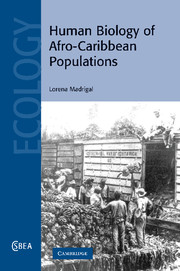Book contents
- Frontmatter
- Contents
- Foreword
- Acknowledgments
- 1 The African slave trade and the Caribbean
- 2 Obesity, hypertension, and non-insulin-dependent diabetes in Afro-Caribbean populations: an evolutionary overview
- 3 Infectious disease epidemiology and Afro-Caribbean populations
- 4 Population genetics of Afro-Caribbean groups
- 5 Demography of Afro-Caribbean groups
- 6 The Afro-Caribbean population in Limón, Costa Rica
- References
- Index
1 - The African slave trade and the Caribbean
Published online by Cambridge University Press: 07 August 2009
- Frontmatter
- Contents
- Foreword
- Acknowledgments
- 1 The African slave trade and the Caribbean
- 2 Obesity, hypertension, and non-insulin-dependent diabetes in Afro-Caribbean populations: an evolutionary overview
- 3 Infectious disease epidemiology and Afro-Caribbean populations
- 4 Population genetics of Afro-Caribbean groups
- 5 Demography of Afro-Caribbean groups
- 6 The Afro-Caribbean population in Limón, Costa Rica
- References
- Index
Summary
The Caribbean
The question of what geographical region is actually to be included in a book about the Caribbean is not as easy a question as it sounds. However, since this book deals with the biology of human populations of African ancestry, it will cover those regions in the Caribbean, broadly defined, occupied by people whose ancestors were brought from Africa by the European slave traders. A broadly defined Caribbean includes the Antilles – the Greater Antilles and the Lesser Antilles – the Grenadines, the Windward Islands, the West Indies, the northern coast (the “shoulder”) of South America, the Atlantic coast of Central America (Belize had true plantation economies with slave populations, whereas most of Central America did not), and Bermuda (though the latter is situated well into the Atlantic Ocean; Figure 1.1). Excluded here are the coast of the Gulf of Mexico and Florida. The Internet provides excellent cartographic resources on the Caribbean. For example, see http://palmm.fcla.edu/map.
The European invasion of the Caribbean and the early import of African slaves
For an overview on the origin and evolution of Native American populations, the reader is referred to Crawford (1998). For recent work on ancient DNA of Caribbean native groups the reader is referred to Lalueza-Fox et al. (2001, 2003). Also recommended is Cook's Born to Die (1998), a book which details the earliest stages of the European–Amerindian contact in the Caribbean.
- Type
- Chapter
- Information
- Human Biology of Afro-Caribbean Populations , pp. 1 - 33Publisher: Cambridge University PressPrint publication year: 2006



